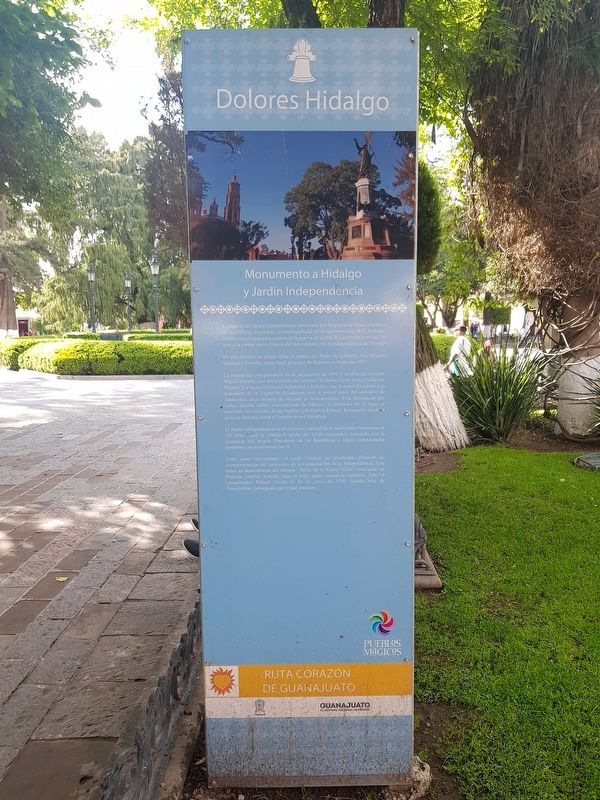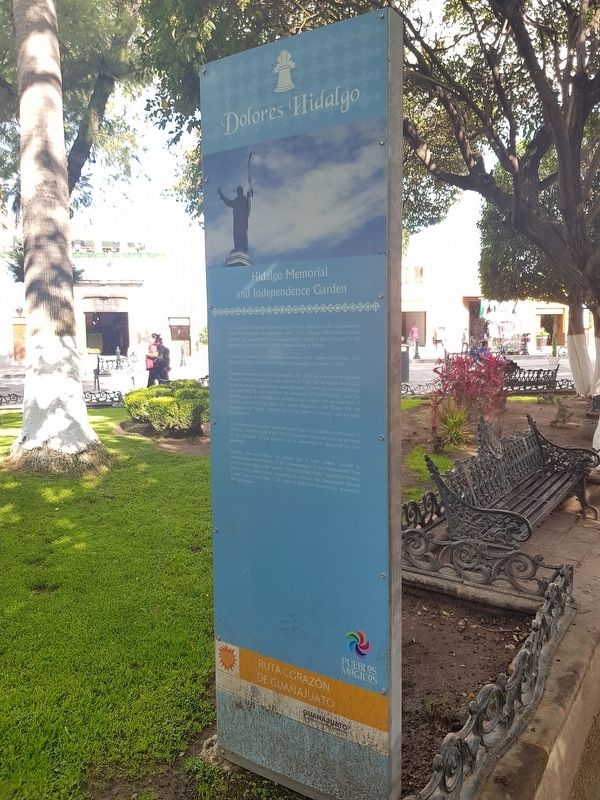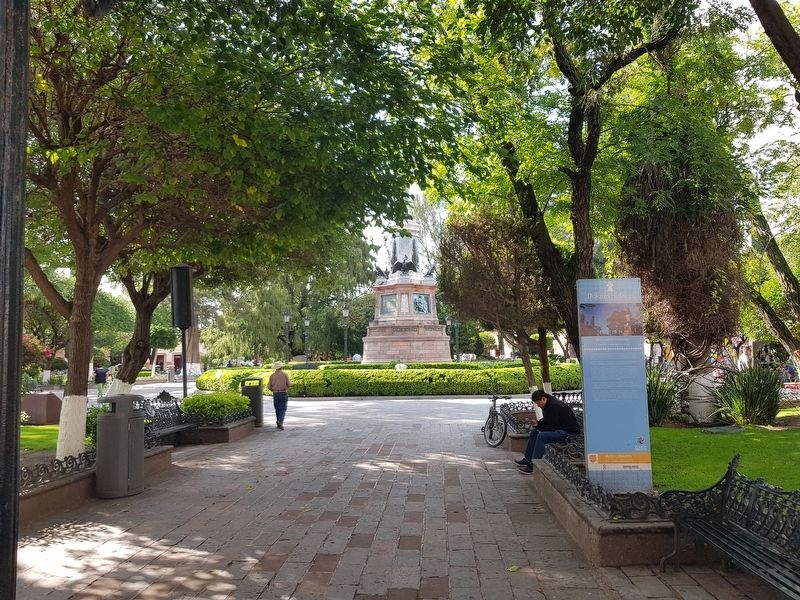Dolores Hidalgo, Guanajuato, Mexico — The Central Highlands (North America)
Hidalgo Memorial and Independence Garden
Ruta Corazón de Guanajuato
Inscription.
El espacio del Jardín Independencia, dominado por la Iglesia de Nuestra Señora de los Dolores, fue donde, la madrugada del 16 de septiembre de 1810, Hidalgo reunió a sus tropas para comenzar la guerra en contra del gobierno virreinal, lo que, a la postre, sería el inicio del movimiento por la independencia de México.
En este entorno no puede faltar la estatua del Padre de la Patria, Don Miguel Hidalgo y Costilla, quien llegó al curato de Dolores en el año de 1803.
La estatua fue inaugurada el 16 de septiembre de 1891 y es obra del escultor Miguel Noreña, que era profesor del Instituto de Bellas Artes en la Ciudad de México. La figura en bronce representa a Hidalgo, con la mano levantada y el estandarte de la Virgen de Guadalupe, que el prócer tomó del santuario de Atotonilco, días después de iniciado el levantamiento. Está flanqueada por varias águilas reales, ave nacional de México, y alrededor de la base se inscriben los nombres de las batallas que libró el Ejército Insurgente, desde el grito en Dolores, hasta el Sacrificio en Chihuahua.
El Jardín Independencia es el escenario natural de la tradicional ceremonia de “El Grito”, que se celebra la noche del 15 de septiembre, contando con la presencia del propio Presidente de la República o algún representante nombrado personalmente por él.
Entre otras curiosidades, el jardín incluye un ahuehuete, plantado en conmemoración del centenario de la Consumación de la Independencia. Este árbol es descendiente del famoso “Árbol de la Noche Triste”, localizado en Popotla, Distrito Federal, bajo el cual, según cuenta la tradición, lloró el conquistador Hernán Cortés el 30 de junio de 1520, cuando huía de Tenochtitlán, perseguido por tropas mexicas.
Hidalgo Memorial and Independence Garden
The Church of Nuestra Señora de los Dolores, dominates the Independence Garden where, early on September 16th, 1810, Hidalgo rallied his troops to start the war against the colonial government, which in the end would be the beginning of the movement for the independence of Mexico.
In this environment you cannot miss the statue of the Father of the Nation, Don Miguel Hidalgo y Costilla, who came to the parish of Dolores in 1803.
The statue was inaugurated on September 16th, 1891 and was made by sculptor Miguel Noreña, professor at the Institute of Fine Arts in Mexico City. The bronze figure depicting Hidalgo,
raises the banner of the Virgin of Guadalupe in one hand that the hero took from the sanctuary of Atotonilco days after the uprising began. It is flanked by several golden eagles, the national bird of Mexico, and around the base, the names engraved of the battles that the Insurgent Army fought, from the day of the “shout” in Dolores, until his death in Chihuahua.
The Independence Garden is the natural setting of the traditional ceremony of “El Grito”, held the night of the 15th of September every year, with the presence of the President of the Republic or a representative appointed by him personally.
Among other curiosities, the garden has a bald cypress, planted to commemorate the centenary of the Consummation of the Independence. This tree is a descendant of the famous “Tree of the Sad Night”, located in Popotla, Mexico City, under which, according to tradition, the conquistador Hernán Cortés wept on June 30th, 1520, when he fled from Tenochtitlan, pursued by Mexica troops.
Topics. This historical marker is listed in these topic lists: Colonial Era • Parks & Recreational Areas • Wars, Non-US. A significant historical date for this entry is June 30, 1520.
Location. 21° 9.461′ N, 100° 56.077′ W. Marker is in Dolores Hidalgo, Guanajuato. Marker is on Calle Guanajuato just west of Calle
Querétaro, on the left when traveling west. The marker is towards the center of the central park of Dolores Hidalgo, just northwest of the statue to Miguel Hidalgo. Touch for map. Marker is in this post office area: Dolores Hidalgo GTO 37800, Mexico. Touch for directions.
Other nearby markers. At least 8 other markers are within walking distance of this marker. The Decrees of Benito Juárez in Dolores Hidalgo (a few steps from this marker); Casa de Visitas (within shouting distance of this marker); House of Mariano Abasolo (within shouting distance of this marker); Miguel Hidalgo and the First Insurgents (within shouting distance of this marker); Miguel Hidalgo (within shouting distance of this marker); The Route of Hidalgo (within shouting distance of this marker); From Here Hidalgo Proclaimed Mexican Independence (within shouting distance of this marker); Cocomacán (within shouting distance of this marker). Touch for a list and map of all markers in Dolores Hidalgo.
Credits. This page was last revised on September 24, 2018. It was originally submitted on September 24, 2018, by J. Makali Bruton of Accra, Ghana. This page has been viewed 153 times since then and 14 times this year. Photos: 1, 2, 3. submitted on September 24, 2018, by J. Makali Bruton of Accra, Ghana.


